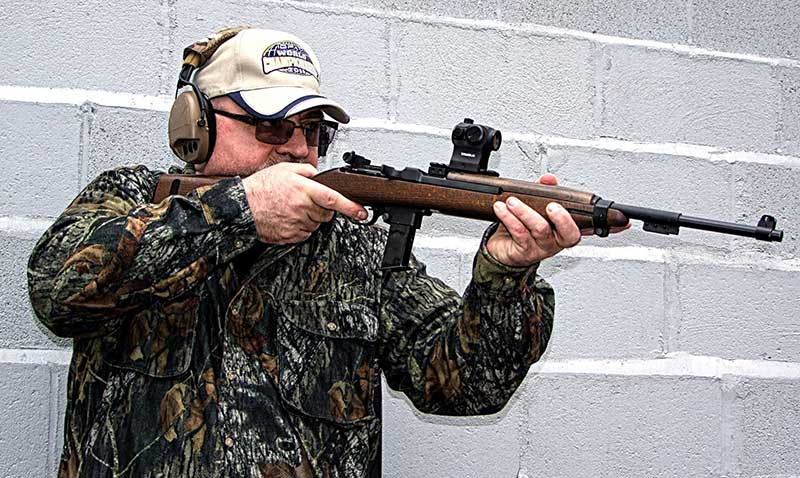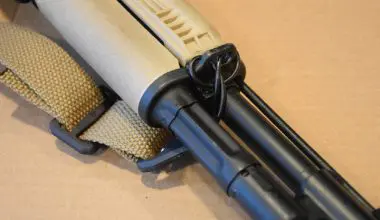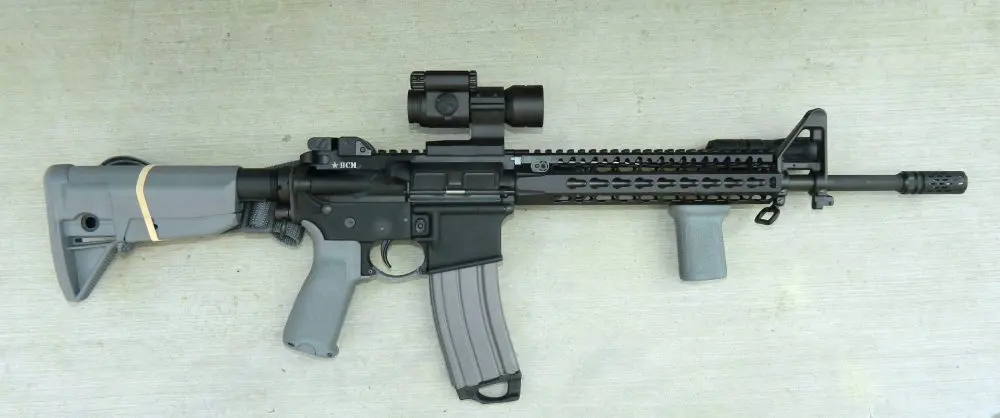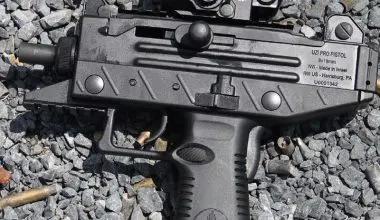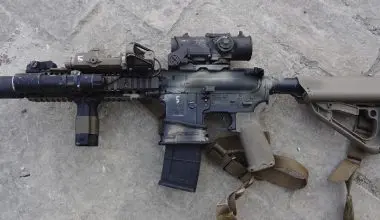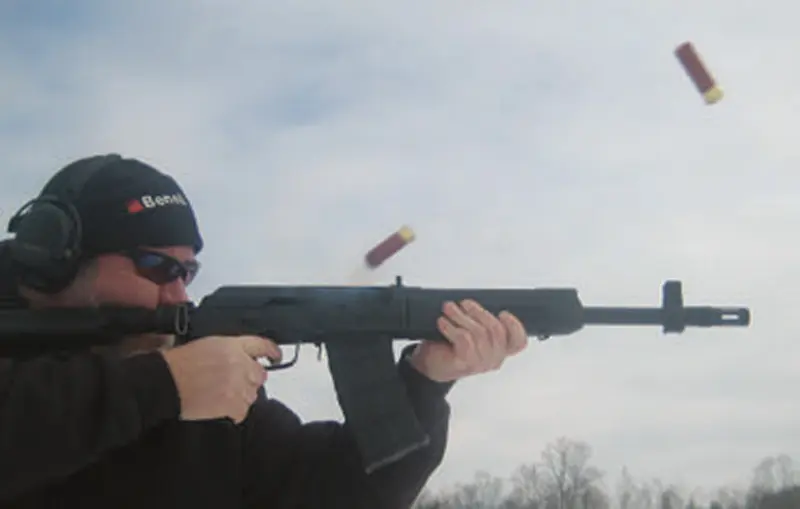
THE operating standard for the combat shotgun has been the pump-action fed via a tube magazine located under the barrel.
There have been lever and bolt-action shotguns as well, but these did not impinge on the pump-action’s status to which all others are compared. This is based on its simplicity of operation, reliability and ability to handle a multitude of ammunition types.
While semiautomatic shotguns have showed capability, few have demonstrated the “hell and back” reliability necessary to gain the confidence of users in life or death situations.
Leave it to the Russians to adapt their ultra-reliable AK operating system to the combat shotgun, with the Saiga- 12—a scaled-up AK-style action fed from detachable magazines.
Table of Contents
SAIGA-12
To give credit where it’s due, Gennady Nikonov is the Russian designer responsible for taking Kalashnikov’s AK design and adapting it into shotgun form.
The Saiga-12 uses a rotating bolt operated by gas piston à la the AK. Obviously, a 12-gauge shell is much larger than a 7.62x39mm rifle round. The 12-gauge flat-hull design further compounded adaptation issues, especially in terms of magazine design.
In brief, the Saiga-12’s rear and forward trunnions were reinforced, with the op-rod piston shortened and bolt carrier modified, allowing for shell clearance during the ejection process in the firing cycle. The bolt head was enlarged to accommodate the larger 12-gauge shell face along with the top cover opening, to provide clearance for the larger 12-gauge shells as compared to the original rifle round size.
While the stock Saiga-12 is a viable weapon, this article will detail what is possible when a standard Saiga-12 is turned over to a knowledgeable AK gunsmith such as Krebs Custom.
KREBS CUSTOM
Krebs Custom was one of the first AK “smiths” of note in the U.S., pioneering work on AK rifles and Saiga shotguns. Though modified to meet import requirements via sporter stock with no pistol grip, the heart of the Saiga shotgun is an AK operating system.
Modifying the Saiga back into the more familiar AK profile, albeit with a much larger hole in the barrel, is a well known and relatively straightforward process that involves moving the trigger guard forward to make room for a pistol grip, replacing the fire control group, and installing an AK stock of choice.
The Krebs Custom Tac-18 is all business with its matte black finished receiver, 18-inch barrel including muzzle brake mated to foldable/collapsible rear stock, SAW-type pistol grip, and black synthetic forearm. It has an overall length of 38 inches with VLTOR stock fully extended, and it weighs seven pounds empty.
Krebs installs and tunes a G2 trigger along with dehorning and smoothing the Saiga’s edges. A Krebs Mk IV safety is fitted to the Tac-18. The Mk IV safety features a manual bolt hold open notch in an effort to provide one possible solution to the Saiga magazine change conundrum, which we will go into more detail about below. A Krebs ghost ring sight finishes off the Tac-18 package. The front sight assembly is moved to the barrel’s muzzle area, thus extending the effective sight radius beyond the standard notch and bead provided by the factory.
The AK operating action is the gold standard for reliability in assault rifles, and the Saiga-12 follows this pattern.
MAGAZINE FED
We should not be biased against the Saiga-12 with our proclivity for tube-fed shotguns. The magazine-fed Saiga-12 positively impacts handling by locating the ammunition at the center of the weapon, allowing for faster handling. The Saiga changes previously instilled training centered on tube-fed shotguns such as “shoot two, load two” techniques, and is closer to an assault rifle in its manual of arms versus the tube-fed shotgun most are more familiar with.
The Krebs Custom Saiga-12 Tac-18 is fed via five-, eight-, 10-, and 12-round stick magazines, along with drum magazines with capacities as high as 30 rounds. I was fortunate to utilize AGP stick magazines of different capacities combined with high-capacity drums from MD Arms and Alliance Armament. The drums represent performance enhancement in a big way.
The Saiga-12 has its own unique characteristics that need to be accepted for the most efficient use of the platform. The Saiga-12 does not have a last round hold open feature, which complicates reloads, especially if magazines are topped off to capacity. The size of the 12-gauge shells makes full-capacity magazines problematic to lock in place with the bolt forward.
Different methods can be employed, such as downloading magazines to make it easier to compress the magazine’s spring. This is not preferred by many, considering the limited capacity of the stick magazines to begin with.
Magazine changes are definitely different in nature, even if you are already familiar with the AK “rocking” method via rifles. The girth and weight of the Saiga magazines take time to get used to when performing reloads under speed, and this is compounded by the need to keep the Saiga’s bolt held open to allow for the magazine insertion.
The Krebs Mk IV safety with bolt hold open notch proved a worthy addition to the Krebs Custom Saiga-12 Tac-18 in this regard.
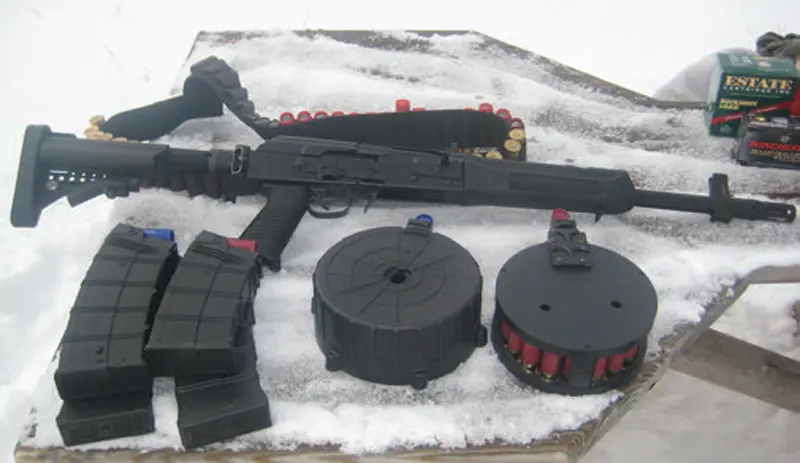
AMMUNITION
In terms of combat or personal defense, shotguns primarily fire two types of shells—slugs or buckshot. There are various types of each. We will confine our discussion to 1-ounce Foster-type slugs. #00 buckshot is generally loaded with eight to nine .33-caliber pellets weighing 54 grains each. This ability to handle different styles of projectiles is at the root of the shotgun’s effectiveness and popularity.
The Krebs Custom Tac-18 was tested with Wolf Ammunition and Federal Premium #00 buckshot 2 ¾” (9 #00 pellets). The Federal Premium FliteControl buckshot load utilizes special wads for tighter buckshot patterns and thus longer effective range. Federal Premium, Winchester, and Wolf 1-ounce slugs were also tested with the Krebs-modified shotgun.
The recently introduced Winchester PDX 1 12-gauge loading that combines a 1-ounce slug and three #00 pellets was also tested.
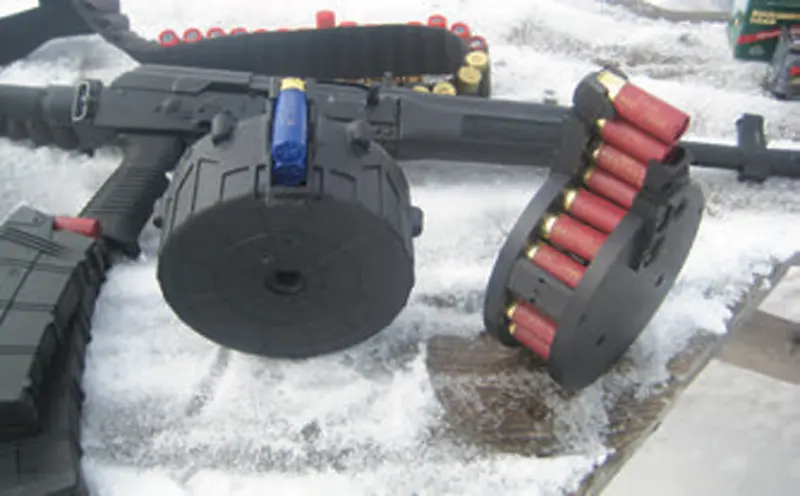
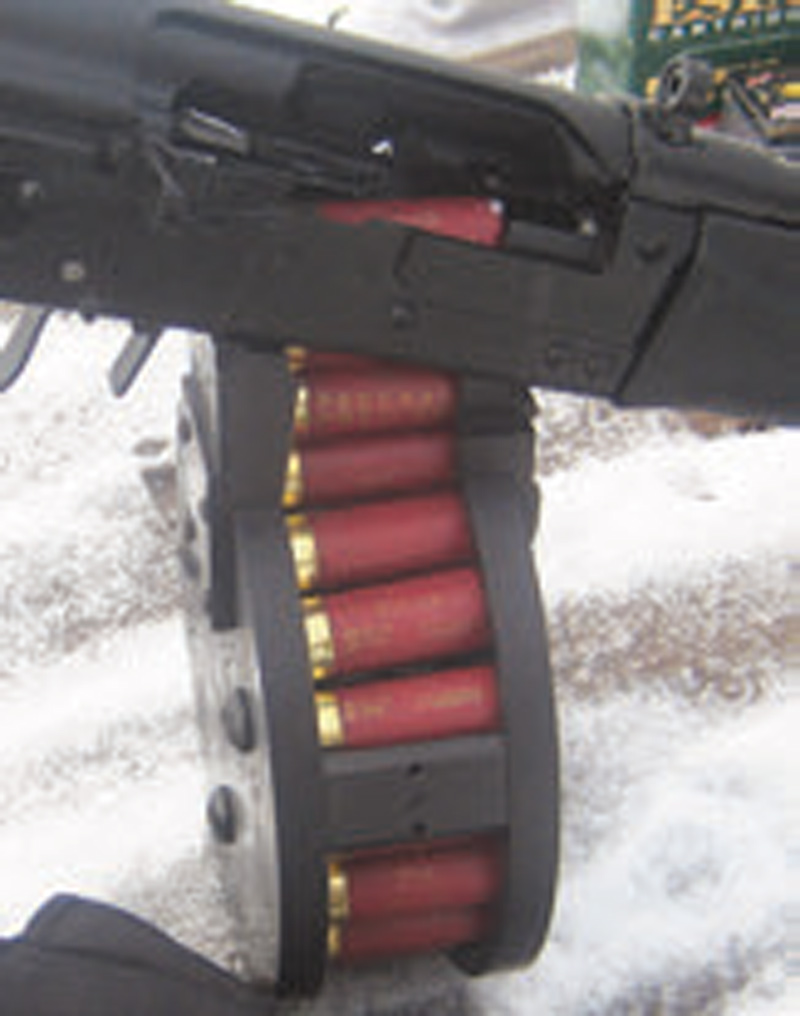
SHOOTING RESULTS
The Krebs Tac-18 cylinder bore barrel generated spreads of five to ten inches at ten yards with the tested buckshot loads. This indicates that a shotgun must be aimed to ensure accurate shot placement at close ranges. The buckshot spread increased to 12 to 22 inches at 25 yards, with the Federal Premium load on the tighter side of the average.
Wolf Ammunition buckshot would not load into the MD Arms and Alliance Armament drum magazines due to its overall length. The drum magazines are for 2¾” shells and, though the Wolf Ammunition is listed as such, it did not fit. It had no issues with the AGP stick magazines.
Many would comment that past 30 yards, one should resort to slugs. Testing with the Krebs Saiga-12 Tac-18 combined with Federal Premium FliteControl buckshot indicated otherwise. The combination was able to place the majority of its pellets on IPSC-style silhouette targets out to 40 yards. Each pellet strikes with a force roughly equivalent to that of .380 ACP.
Slugs performed in the four-inch range at 50 yards in the Krebs Saiga-12, with the ghost ring sights proving their worth. Man-sized steel targets were hit regularly at 100 yards. A certain amount of satisfaction was derived when witnessing the slugs rocking the target back on its base.
Nearly 400 rounds of various loads were fired in this T&E, including light birdshot. The only time reliability issues were encountered was when the magazine was used as a vertical foregrip. Once the offhand was moved forward to the forend, reliability was restored.
At times I had difficulty getting the magazines inserted—user error, not equipment—but worth mentioning to emphasize training with a weapon platform to ensure proficiency.
The Saiga-12 gas system has two settings, meaning it can be adjusted to the ammunition type used. This system allows for use of most any ammunition type, including low brass shells, and aids in recoil management by utilizing the restricted gas flow setting when firing full-power buckshot or slug loads. Low-recoil buckshot or slug loads, such as the Federal Premium selections tested, need to be proofed for which setting works best. The Krebs Tac-18 setting was not moved during testing and worked with everything from low brass birdshot to slugs.

Disassembly for maintenance is simple and permits effective cleaning in minimal time.
Range time consisted of the patterning described above, along with other exercises aimed at gaining a better appreciation of how the Krebs Saiga-12 shotgun handles and performs.
TTPs
One of the most crucial things to learn when choosing a shotgun for defense is how to keep it from running empty of ammunition.
Typical shotgun techniques must be avoided when deploying the Krebs Tac-18, which is best operated as a magazine-fed assault rifle. The drills involved moving between barricades engaging shoot and no-shoot targets. Another drill was based on engaging several shorter-range targets out to 30 yards before having to engage a designated target placed 90 yards away. This necessitated a switch from buckshot to slug before engaging.
The Krebs Tac-18’s ghost ring sight comes into its own during this type of work. The ghost ring gives nothing up in terms of CQB ranges. The front sight was as easy to place on target as a bead and ultimately proved better at accurate placement of fire.
Shooting clay targets is a great test for any shotgun, especially one to be used in a quick-reacting CQB setting. This also verifies reliability with ammunition with less recoil impulse than slugs or buckshot and helps get more rounds fired to verify operating soundness. Low brass Wolf Ammunition and Federal Premium #7.5 shot were used with no issue. The ghost ring sight caused no problem at all, with the rear sight “disappearing” naturally as the eye focused on the flying clay target and front sight leading it.
The low brass shells were a welcome relief in terms of recoil. Yes, the Krebs Tac-18 is semi-automatic, but it still is a 12 gauge, and anyone telling you any different should be given the side eye.
Magazines for the Saiga-12 are becoming more available, with AGP Arms leading the way with six-, eight- and ten-round magazines.
DRUM MAGAZINES
Another way to feed the Krebs Tac-18 is drum magazines. I was fortunate to access two of the better designs on the market in the form of the MD Arms and Alliance Armament 20-round drum magazines.
The Saiga-12 action is reportedly the fastest available, even surpassing the Benelli. Krebs Custom modifications, such as adding a pistol grip, allow this feature to be explored to its fullest, especially with drum-fed magazines.
I came to favor the drum magazines over the stick magazines because I did not feel proficient at getting the stick magazine changes accomplished smoothly. More training time would surely increase my confidence and skill. Another nuance discovered with using the drum magazines is that hand placement on the forend needs to be pushed forward slightly more than normal to get around the drum’s circumference.
A definite nuance with operating the Saiga-12 is magazine manipulation. You must make sure all magazines fit and function with your shotgun.
The Krebs Tac-18 equipped with a drum magazine plus stick magazines or another drum magazine residing in a slung pouch is a different beast entirely than an eight-round tube fed shotgun, especially in a personal defense or law enforcement environment. My time with the Krebs Custom Tac-18 convinced me that the Saiga-12 is worthy of consideration as an alternative to the tube-fed shotgun.
The Krebs Custom portion of the Saiga-12 shotgun equation is a significant upgrade over a standard Saiga-12 shotgun as it arrives stateside. Base Saiga-12 shotguns cost in the $500 to 600 range, with Krebs Custom work adding to this cost. But in my opinion it’s well worth it, to get the most out of the platform.
